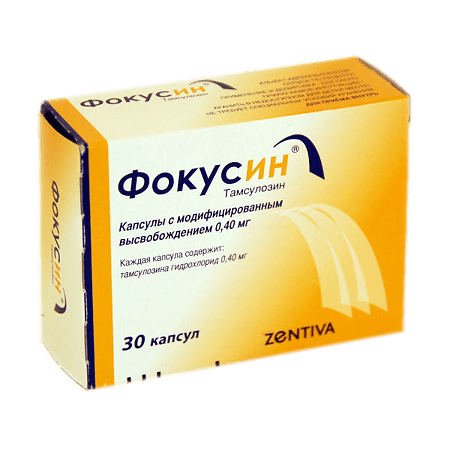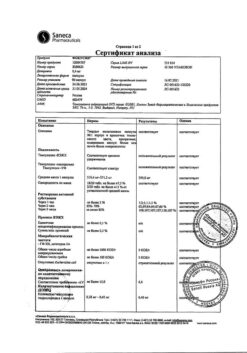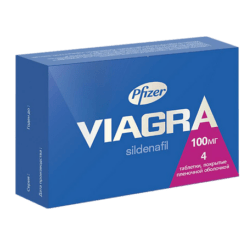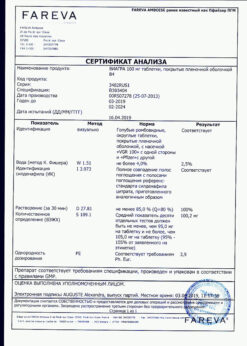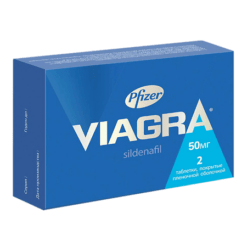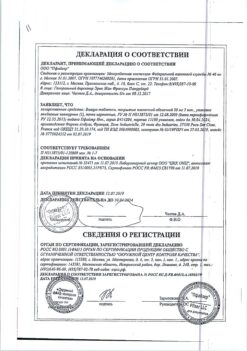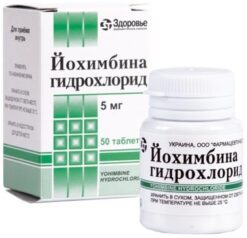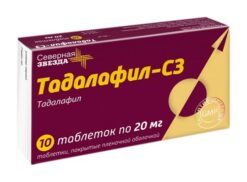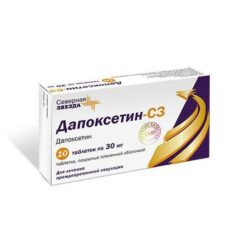No products in the cart.
Focusin, 0.4 mg 30 pcs.
€14.73 €12.76
Description
Pharmacodynamics
. Tamsulosin selectively and competitively blocks postsynaptic a1A-adrenoreceptors located in the smooth muscle of the prostate, bladder neck and prostatic part of the urethra, as well as a1D-adrenoreceptors, mainly located in the bladder body. This leads to decrease of tone of the smooth muscles of the prostate, bladder neck and prostatic part of the urethra and improvement of detrusor function. Due to this, symptoms of obstruction and irritation associated with benign prostatic hyperplasia are decreased. As a rule, therapeutic effect develops within 2 weeks after the beginning of therapy, although some patients show reduction of symptoms after the first dose.
The ability of tamsulosin to affect a1A-adrenoreceptors is 20 times greater than its ability to interact with a1B-adrenoreceptors which are located in vascular smooth muscle. Due to this high selectivity, the drug does not cause any clinically significant decrease in systemic arterial blood pressure (BP) both in patients with arterial hypertension and in patients with normal baseline BP.
Pharmacokinetics
Intake
After oral administration, tamsulosin is rapidly and almost completely absorbed from the GI tract. Bioavailability of the drug is about 100%. After a single oral dose of 400 mcg the Cmax of the active substance in plasma is reached after 6 hours.
Distribution
At equilibrium state (after 5 days of therapy) the Cmax( of active substance in plasma is 60-70% higher than Cmax after a single dose of the preparation. Binding to plasma proteins is 99%. Tamsulosin has low volume of distribution (approximately 0.2 l/kg).
Metabolism
Tamsulosin does not undergo “first pass” effect and is slowly biotransformed in the liver to form pharmacologically active metabolites with high selectivity for a1-adrenoreceptors. Most of the active substance is present in the blood unchanged.
Elimination
Tamsulosin is excreted by the kidneys, 9% of the dose is excreted unchanged.
The T1/2 of tamsulosin in single administration is 10 hours, after multiple administration – 13 hours, the terminal elimination half-life is 22 hours.
Indications
Indications
Treatment of functional symptoms in benign prostatic hyperplasia.
Pharmacological effect
Pharmacological effect
Pharmacodynamics
Tamsulosin selectively and competitively blocks postsynaptic α1A-adrenergic receptors located in the smooth muscles of the prostate gland, bladder neck and prostatic urethra, as well as α1D-adrenergic receptors predominantly located in the body of the bladder. This leads to a decrease in the tone of the smooth muscles of the prostate gland, bladder neck and prostatic urethra and improved detrusor function. This reduces the symptoms of obstruction and irritation associated with benign prostatic hyperplasia. As a rule, the therapeutic effect develops 2 weeks after starting the drug, although some patients experience a decrease in the severity of symptoms after taking the first dose.
The ability of tamsulosin to act on a1A-adrenergic receptors is 20 times greater than its ability to interact with a1B-adrenergic receptors, which are located in vascular smooth muscle. Due to this high selectivity, the drug does not cause any clinically significant decrease in systemic blood pressure (BP) both in patients with arterial hypertension and in patients with normal baseline blood pressure.
Pharmacokinetics
Suction
After oral administration, tamsulosin is quickly and almost completely absorbed from the gastrointestinal tract. Bioavailability of the drug is about 100%. After a single oral dose of 400 mcg, Cmax of the active substance in plasma is achieved after 6 hours.
Distribution
At steady state (after 5 days of course administration), the Cmax values of the active substance in the blood plasma are 60-70% higher than Cmax after a single dose of the drug. Plasma protein binding is 99%. Tamsulosin has a small volume of distribution (approximately 0.2 l/kg).
Metabolism
Tamsulosin does not undergo the “first pass” effect and is slowly biotransformed in the liver with the formation of pharmacologically active metabolites that retain high selectivity for α1A-adrenergic receptors. Most of the active substance is present in the blood unchanged.
Removal
Tamsulosin is excreted by the kidneys, 9% of the dose is excreted unchanged.
T1/2 of tamsulosin with a single dose is 10 hours, after multiple doses – 13 hours, the final half-life is 22 hours.
Special instructions
Special instructions
Tamsulosin should be used with caution in patients with a predisposition to orthostatic hypotension. At the first signs of orthostatic hypotension (dizziness, weakness), the patient should be seated or laid down.
Before starting to use the drug, it is necessary to verify the diagnosis.
During the treatment period, care must be taken when driving vehicles and engaging in other potentially hazardous activities that require increased concentration and speed of psychomotor reactions.
Active ingredient
Active ingredient
Tamsulosin
Composition
Composition
active ingredient:
tamsulosin hydrochloride 0.4 mg
excipients:
30% methacrylic acid-ethacrylate copolymer dispersion (1:1),
microcrystalline cellulose,
dibutyl sebacate,
polysorbate 80,
colloidal silicon dioxide,
talc.
capsule shell:
azorubine, dye Patent blue V, gelatin.
Contraindications
Contraindications
Hypersensitivity to the components of the drug Focusin.
With caution: chronic renal failure (decrease in creatinine clearance below 10 ml/min), arterial hypotension (including orthostatic), severe liver failure.
Side Effects
Side Effects
Rarely – headache, dizziness, asthenia, sleep disturbance (drowsiness or insomnia), retrograde ejaculation, decreased libido, back pain, rhinitis, nausea, vomiting, constipation or diarrhea.
In isolated cases – orthostatic hypotension, tachycardia, palpitations, chest pain.
In extremely rare cases, hypersensitivity reactions (skin rash, itching, angioedema).
Interaction
Interaction
Cimetidine increases the concentration in plasma, furosemide decreases it (has no significant clinical significance).
Diclofenac and indirect anticoagulants slightly increase the rate of elimination of tamsulosin.
The simultaneous use of tamsulosin with other alpha1-blockers can lead to a pronounced increase in the hypotensive effect.
Overdose
Overdose
There were no cases of acute overdose of the drug.
Symptoms: Acute hypotension is theoretically possible.
Treatment: cardiotropic therapy is performed. If symptoms persist, volume replacement solutions or vasoconstrictors should be administered.
To prevent further absorption of tamsulosin, gastric lavage, activated charcoal or an osmotic laxative may be taken.
Storage conditions
Storage conditions
Under normal conditions
Shelf life
Shelf life
2 years
Manufacturer
Manufacturer
Saneka Pharmaceuticals a.s., Slovakia
Additional information
| Shelf life | 2 years |
|---|---|
| Conditions of storage | Under normal circumstances |
| Manufacturer | Saneka Pharmaceuticals a.s., Slovakia |
| Medication form | modified-release capsules |
| Brand | Saneka Pharmaceuticals a.s. |
Other forms…
Related products
Buy Focusin, 0.4 mg 30 pcs. with delivery to USA, UK, Europe and over 120 other countries.

